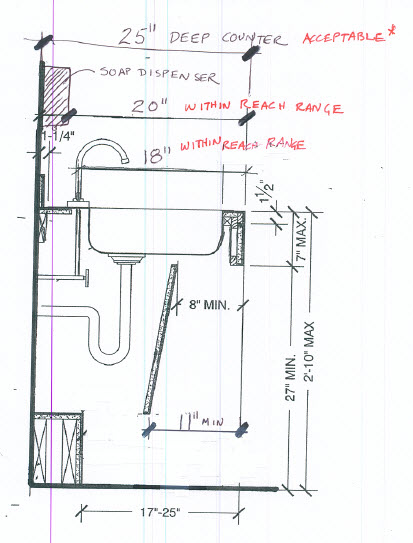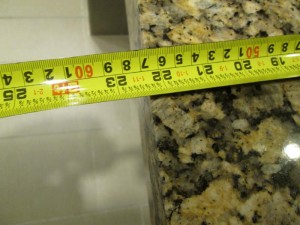Reach Ranges at Sinks
Posted on - Friday, January 2nd, 2015Happy New Year 2015!
We are excited to submit our first newsletter of the year!
The 2010 ADA (and 2009 ANSI) mandates that an operable part of an accessible element must be reachable either through a forward approach or a side approach. Sometimes the Standards provide figures that can be confusing when it comes to dimensions and what the dimensions refer to. Is it the depth of the counter that we care about? Is it the operable part you are reaching to? How does an electrical outlet figure in? What are the requirements for distance of faucets and other accessories? This newsletter will clear up some of the misconceptions.
Obstructed Forward Approach Reach Range
If you must reach over an obstruction, such as a counter, a drinking fountain, or other element, using a forward approach, a knee space is required.
If a knee space is provided, and the object that you are reaching for is located no more than 20″ from the edge of the counter, the object must be mounted no higher than 48″ a.f.f. and it will be considered accessible.
If the object is located between 20″ to 25″ from the edge of the obstruction, then the element must be mounted lower, at 44″ maximum above the ground.

Notice that the figure DOESN’T tell us how deep a counter should be. As a matter of fact, a counter can really be as deep as you want as long as the reach range is maintained. Let’s try to take it one dimension at a time.

The top dimension shows that the depth of the counter is 25″. That dimension is acceptable. It would have also been acceptable if it was 26″ or deeper. The depth of the counter is NOT restricted. The distance to the object that you are reaching for IS what is restricted.
For example, the soap dispenser shown on the section is 20″ away. That distance is acceptable as long as it is mounted no higher than 48″ a.f.f.
The faucet is dimensioned as 18″ away from the edge. That distance is also acceptable according to the forward approach reach range.

This counter shows the forward approach reach range. The soap dispenser is at an accessible height, but the paper towel is it higher than the required accessible height. Both are at the proper distance from the edge, since we count the distance to the operable part, and not the wall where they are mounted on.
Knee and Toe Clearance
For a forward approach, a knee clearance based on section 306 is required. The figures below shows the requirements. One is for the toes, which require a minimum of 17″ at the ground and an availability of a 6″ clearance beyond any pipes or panels that may be part of the cabinet.

The knee space requires a minimum of 27″ of height from the ground to the bottom of the counter. It also requires a minimum of 8″ horizontal clearance at the top and a minimum of 11″ plus the additional 6″ for toe clearance (17″ min.) at the ground.

The section below shows a drawing from a designer, and I will explain what is commonly misunderstood

A 17″ minimum clear floor space must be provided measured from the edge of the counter to any obstruction beyond the edge. Just keep in mind that the first 11″ of that required clear floor space is considered knee clearance. The next 6″ only is considered toe clearance. Since only 6″ out of the 17″ clearance will be considered toe clearance, any more than that is not relevant.
Obstructed side approach reach range
A Side approach reach range is more restrictive than a forward approach. For one thing, the height of the obstruction MUST only be 34″ a.f.f. A taller counter cannot be used if a side approach reach range is required.


This section shows a 3′-0″ tall counter. No matter how low the soap dispenser is or even how close the faucet is from the edge, these cannot be reached from the side. There is one EXCEPTION. If the distance from the edge to the element is no more than 10″ away, then it is not considered an obstruction and it can be mounted on a counter higher than 34″ a.f.f.

If you do have a counter that is 34″ a.f.f. ,you may use the side approach reach ranges. The section below shows you the acceptable ranges. Notice one of the dimensions is correct. The faucet is within the side approach reach range. But sometimes an outlet is located on the back of the wall beyond the back splash. If the counter is 24″ deep and the back splash is 3/4″, then the outlet mounted on the back wall will be 24 3/4″ away from the edge. This is beyond the allowable reach range for a side approach.



The outlet behind the counter was located 25″ away from the edge

There are two outlets in this break room and one could be reached on the side of the counter.


The faucet in this sink was located 22″ away from the edge which is within reach range

This type of drinking fountain has a bottle filler mechanism. If it is located at the high drinking fountain with an open knee space, it can be reached using a forward approach reach range since the height of the obstruction is not an issue. The only requirement is that the sensor be located no farther than 25″ away and no higher than 48″ a.f.f.
This one complied.
Happy New Year!
we look forward to serving you in 2015! Let us know if there is anything we can do to make the standards a little easier to understand.
If you are interested in getting a Barrier Free/ADA CEU online, I partnered with Green CE
If you are interested in Building Code seminars check out my colleague Shahla Layendecker with SSTL Codes
If you want to learn more about these standards, be sure to check out my books:
“The ADA Companion Guide” “Applying the ADA” published by Wiley.


They are available for sale now. (also available as an e-book)
If you have any questions about these or any other topics, please feel free to contact me anytime.
Marcela Abadi Rhoads, RAS #240
Abadi Accessibility
214. 403.8714
marhoads@abadiaccess.com
www.abadiaccess.com
 Abadi
Abadi 


